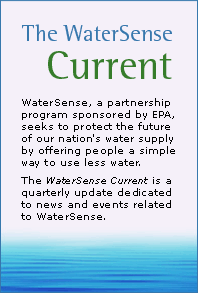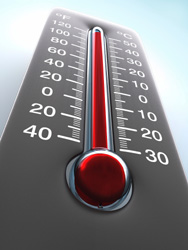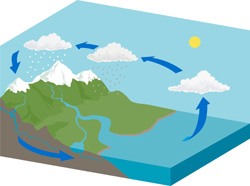The WaterSense Current Summer 2009
In This Issue XI, Summer 2009:
 |
In This Issue: |
Less Is More—a Lot More
Savings, that is. In 2008, consumers who installed WaterSense labeled toilets, faucets, and faucet accessories helped save more than 9.3 billion gallons of water and realized $55 billion in savings on water and sewer utility bills.
These savings resulted from the sale of 1.38 million WaterSense labeled toilets and 4.4 million WaterSense labeled bathroom faucets and aerators. To date, buyers can choose from more than 300 different toilet models and more than 1,000 different types of water-saving faucets and accessories such as aerators that have earned the WaterSense label since 2007.
And water is only part of the equation. WaterSense labeled faucets saved U.S. households nearly 1 billion kilowatt hours (kWh) of electricity from not heating the extra water, and utilities saved an additional 25 million kWh of electricity that otherwise would have been needed to pump and treat that water. This avoided the production of nearly 1 million metric tons of greenhouse gas emissions, equivalent to removing 180,000 automobiles from the road for one year. Something to contemplate the next time you wash your hands—with a WaterSense labeled faucet, we hope.
Water Use: Drop It When It's Hot

When the mercury rises, so does your water use. “Peak” water use describes the time of year when residential water use is at its highest, usually late July and early August, depending on where you live. While using water efficiently is important throughout the year, sometimes the timing of water use can make a big difference for water supplies—and your water bill.
An average household's water use is 260 gallons per day. By contrast, peak seasonal water use is around 1,000 gallons per day. Some households use as much as 3,000 gallons on an extreme peak day! That's equivalent to a garden hose running open for nearly eight hours. Water use will peak on an hourly basis, too, usually between 6:00 a.m. and 9:00 a.m., with a secondary peak between 6:00 p.m. and 9:00 p.m.
During the summer, when water use is typically two to four times that of winter water use, peak periods are an issue, as water systems—even those with plentiful supplies—can be taxed by this spike in demand. Extreme demand for watering lawns, washing cars, filling backyard pools, and enjoying other warm-weather activities can outstrip supply, cause increased capital expenditure for the water system, tax water infrastructure, lead to a rise in pollution levels, and require new water sources to be created solely for those peak use periods.
To reduce costs and ensure adequate supply for all customers, water systems across the country encourage residents to limit their water use during the hottest summer days, and to wait to irrigate lawns and gardens, refill pools, or perform other water-intensive tasks until demand is lowest (e.g., before 6:00 in the morning). Landscape contractors can also adjust the timers on irrigation controllers so they will not go off during peak hours.
Proving it can be done, one WaterSense partner, Central
Arkansas Water![]() ,
addressed and successfully shifted peak water use with its “Avoid
the Peak” program, using public service announcements, radio
spots, and bill stuffers.
,
addressed and successfully shifted peak water use with its “Avoid
the Peak” program, using public service announcements, radio
spots, and bill stuffers.
For more information about peak water use, visit the WaterSense Peak Water Use page.
Home Is Where the Smart Is


In its latest effort to bring water efficiency directly to American homeowners, the WaterSense program's specification for water-efficient new homes asks the question, what if you could buy a house that made saving water convenient for you?
Jennifer Bowman and her family of four found out first hand when they became the first family to move into a home built to meet WaterSense criteria for water-efficient new homes. The house, just outside Chapel Hill, North Carolina, touts a host of water-saving features, including kitchen and bathroom fixtures with aerators that reduce the amount of water needlessly sent down the drain as well as WaterSense labeled toilets. “We love this house,” says Bowman. “Living here has enabled us to do good things for the environment, without drastically changing our lifestyle.”
If anything, some aspects of the home have made life more convenient for the Bowmans. Doorbell-shaped buttons in the kitchen and bathrooms flush and re-circulate water through the pipes, allowing hot water to arrive to fixtures quicker, saving time and water. “Guests are curious when they see those buttons, but once we explain it, they think it's the coolest thing… they think we're like the Jetsons,” Bowman says. Indeed, the future is now for homes that can help conserve water resources without giving up quality of life.
Saving some serious change in the process is another perk. The Bowman family's water bills are routinely in the lowest or second-lowest range of usage possible, and they don't have to obsess over every last drop. Still, the Bowmans, who have always been water-conscious, find that their home's performance motivates them to do their part to conserve water.
“When people think green, they think sacrifice,” says Bowman, “but [in the future] buying a WaterSense labeled home won't change your way of life, and it won't break the bank. It's also the right thing to do for my kids and eventually my grandkids.” Especially in states with recurring drought concerns, conserving water every day by purchasing a home built to the WaterSense program's specification will be a smart investment for future homebuyers and future generations.
The WaterSense program released a revised draft of the specification to establish the criteria for water-efficient new homes in May. The Bowmans' home was built as part of a pilot program in 2009. When the specification is finalized later this year, the voluntary WaterSense New Homes program will open for builders who construct single-family homes and townhomes, three stories or less in size. Visit the revised draft WaterSense new homes specification page for more information about the upcoming program, or learn more about the Bowmans' water-efficient digs in a story featured in University City Magazine (PDF) (3 pp, 1.3MB, About PDF).
Can We Really "Save" Water?

Because water is a renewable resource—and seems so plentiful—you might wonder, “Why do we need to 'save' it? Won't it always be there?” Yes, it's true that thanks to the natural water cycle and modern wastewater treatment facilities, water can be purified and reused over and over. But that's only part of the story. When we use water, we need to understand how our actions affect the water cycle and, ultimately, the availability and quality of water to people around us and downstream.
Water in lakes, reservoirs, and underground aquifers can behave like a finite resource and be depleted at alarming rates during periods of peak usage or drought. Under natural circumstances, the water cycle will recharge these types of water storage…eventually. Unfortunately, water use rapidly increases in the seasons when precipitation is at its lowest, and so water does not recharge quickly enough.
Here's how it works: The water cycle is usually depicted on a global scale, but the cycle takes place on a much more localized level. Communities are typically connected by a common water source called a watershed. A watershed, also referred to as a drainage basin, is a region where all the water that falls on that land drains to a common source of water, such as a river, lake, or aquifer. Communities then access and distribute this water through a public supply system or individuals pump it from wells in a shared aquifer. Water managers maintain a delicate balance between the amount of water available from a given source and the number of customers they feel it can effectively supply.
Ideally, once an upstream community uses water in its homes, it can be treated and made available for another downstream community to use. But not all water continues downriver. As much as 50 percent of water used for lawn irrigation can be lost due to evaporation and overwatering, for example. And evaporated water can travel long distances before returning to the ground as rain, meaning when and where it will fall next continues as a time-worn guessing game.
As populations grow, aging water infrastructure can struggle to keep up with demand. Reducing water use through efficient technologies and tactics, such as installing WaterSense labeled plumbing fixtures or watering your lawn only when necessary, can ease the strain on supply and allow clean water to be shared effectively among more people. To understand that every drop indeed counts, consider that for every nine households that install WaterSense labeled toilets, enough water is saved to supply one more household in the community! Not to mention by saving water, we also conserve energy and help reduce our carbon footprint.
Partner Profile: Ferguson
The WaterSense Current periodically profiles outstanding WaterSense partners and their achievements in advancing water efficiency and water-efficient products and practices.
Founded in 1953, Ferguson Enterprises is the country's largest wholesale distributor of plumbing supplies. As a wholesaler, Ferguson naturally watches the market closely and, in recent years, has seen a growing uptick in business and consumer interest in products that preserve natural resources, including water. So in 2007, Ferguson decided that partnering with WaterSense was a natural step.
Since then Ferguson has continued to develop its support of WaterSense and has placed renewed emphasis on its green initiative, which centers on educating associates and customers to better understand what “being green” is all about.
“Supporting customers' needs for green products makes good business sense,” says Will Hummel, Ferguson's manager of emerging markets and green strategies. The company wants its associates and customers to understand both the environmental and economic benefits of using green products—all the more important in today's economy.
The North American company, a subsidiary of United Kingdom-based Wolseley plc, has educated its staff about the benefits of water efficiency and WaterSense labeled products with remarkable speed for a company of its size. So well, in fact, that this training helped Ferguson win the 2008 WaterSense Partner of the Year for retailers and distributors.
Hummel says the company recognizes that the market for water-saving products will continue to grow, and so Ferguson continues to educate its associates and expand its inventory of water-efficient products to provide customers with solutions to meet their water conservation needs. With 300 showrooms and approximately 1,400 locations across the country, there is a good chance there is a Ferguson near you.
For more information, please visit Ferguson's Web site![]() .
.
Portions of this article, authored by EPA's WaterSense Team Lead Virginia D. Lee, were previously published in Water Efficiency magazine.




